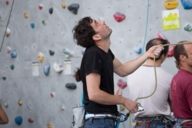
The climbing scene in Munich’s halls has freed itself from the mountainside. And is rocking more than ever before!
The mountains are calling. If I elude their call for too long, they soon catch up with me on my way to work. When the S-Bahn stops off at Munich-Laim, the view from the train window is the Fürstenrieder Strasse, right at the end of which you can see the Zugspitze nestled in amongst the mountains and basking in the morning sun. There, they let me know just how much I’ve been missing them.
The wind whistling down from the Alps heightens my longing for those exhilarating summits, so much so that the mountains appear close enough to touch: To the east, I see Wendelstein, followed by Benediktenwand, Herzogstand and Heimgarten. Further to the west, there is Ettaler Manndl, the Hörnle and the peaks of the Ammergauer Alps.
I love the mountains and, to me, there is nothing better than clambering over the paths and via ferrata to the summit, where I can then enjoy the wonderful views.
I love the mountains and, to me, there is nothing better than clambering over the paths and via ferrata to the summit, where I can then enjoy the pride in everything I’ve achieved and savour the wonderful views. I don’t normally get to enjoy these moments alone for long considering many locals are “Bergfexe”, passionate mountain climbers, who prefer to tend to their inner bond with the local mountains than their own gardens and love nothing more than to spend their free time in nature.
Even the Bavarian royal family enjoyed walking in the mountains. Maximilian II, for example, often took the entire royal household out with him, while his wife Crown Princess Marie of Bavaria became the first female Bavarian climber to scramble through the mountains. The couple’s son, the fairy-tale king Ludwig II, threw eccentric birthday parties at the Schachenhaus near the town of Garmisch-Partenkirchen. Visitors today are still in awe of this luxurious mountain cabin and its oriental design.
Climbing is in! Unfortunately, it takes at least one hour to get to the mountains and the majority of Munich’s residents still need to fit in a bit of work now and then. Instead, there are plenty of indoor and outdoor venues in Munich and the surrounding area where explorers of all experience levels can go climbing and bouldering. All of these venues are also happy to welcome any visitors to Munich keen not to miss out on their favourite sport. Equipment is easily available to hire at all of the halls.
Anyone in the city eager to try their hand at wild bouldering (climbing without a rope at a safe distance to the ground with just a crashpad separating you from the hard woodland floor) should take the S7 to Buchenhain. Here in the Isarhochufer woodland to the south of Munich, not far from the Waldgasthof guesthouse, is where urban climbing has its roots: back when this sport was practised by just a handful of hardcore fans.
Climbing releases a feeling of elation that I haven’t experienced since I was a child climbing trees, walls or the shed roof: the delight of moving your own body and just the right amount of nervous thrill.
In summer, you can rest your limbs after a climb with a cooling swim in the Isar river. I even met other ambitious boulderers here in mid-February, practising a few impressive moves despite their clammy fingers on the icy rock face. Personally, I find bouldering on the slippery rocks in the wild a little too risky. I prefer the thick mats in Munich’s climbing halls.
The Thalkirchen neighbourhood is home to both the world’s largest climbing centre, the DAV Kletter- und Boulderzentrum München (DAV Climbing and Bouldering Centre Munich) and the world’s largest bouldering hall, Boulderwelt München Ost (Boulder World Munich East). The DAV Kletter- und Boulderzentrum München-Nord in Freimann (DAV Climbing and Bouldering Centre Munich North in Freimann) opened in direct proximity to the Allianz Arena as recently as 2015.
East Munich is also home to Heavensgate and High East, while in the west of Munich you will find Boulderwelt München West (Boulder World Munich West) and DAV Kletterzentrum in Gilching (DAV Climbing Centre in Gilching). Artificial climbing centres are significantly safer than mountain climbing. I don’t have to worry about getting hit by falling stones or the weather changing, but still don’t have to miss out on the fresh air. The majority of climbing and bouldering halls also have large outdoor climbing areas.
Very few climbers come here for serious mountain training. However, their love for the sport is serious, making it less like a sport and more like a lifestyle with an addictive quality. Climbing releases a feeling of elation that I haven’t experienced since I was a child climbing trees, walls or the shed roof: the delight of moving your own body and just the right amount of nervous thrill. And a slice of pizza or a burger has never tasted better than during the mandatory discussion of your form that day or the pitfalls of a particular route in the climbing halls’ cafés. I am not surprised to learn that almost a third of the members of Munich Alpenverein (Munich Alp Association) are now active climbers.
I hope you have lots of fun and success climbing and bouldering in and around Munich! And a champion has never fallen off the wall, or have they?
Tip: Munich has evolved into a host for many national and international climbing and bouldering championships. As the venue for the Boulder World Cup, held at the Olympiastadion (Olympic stadium) every August, Munich took its final step to becoming the global capital of competitive climbing when it held its first contest in 2010.